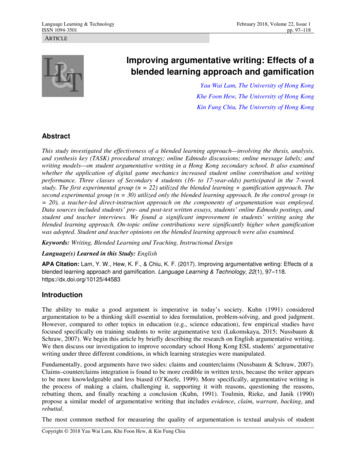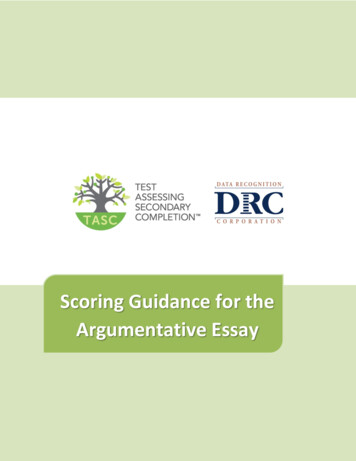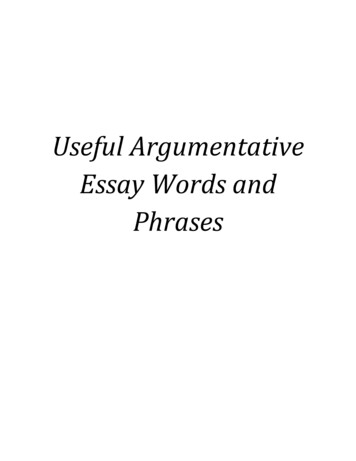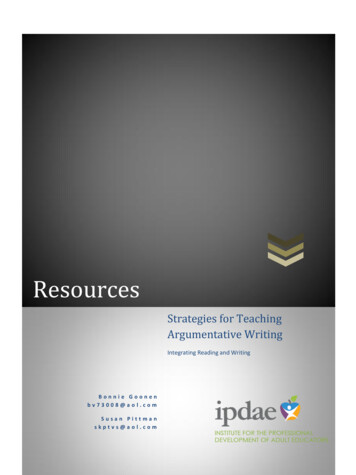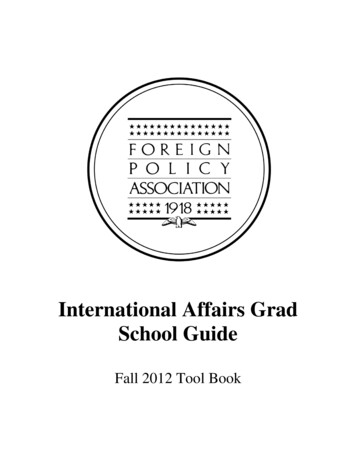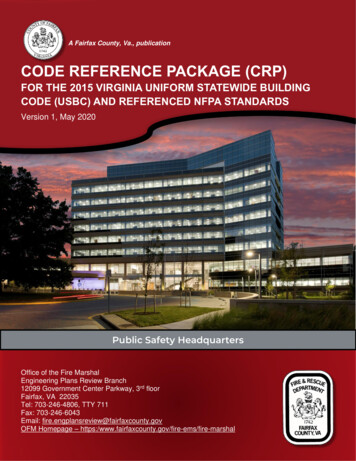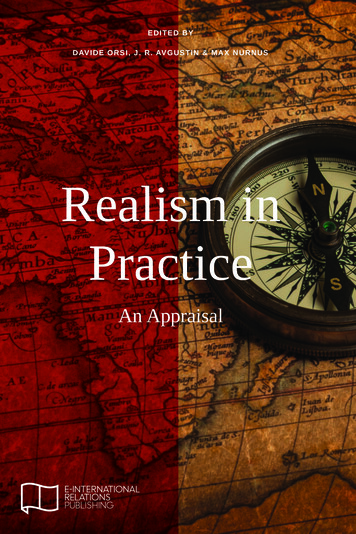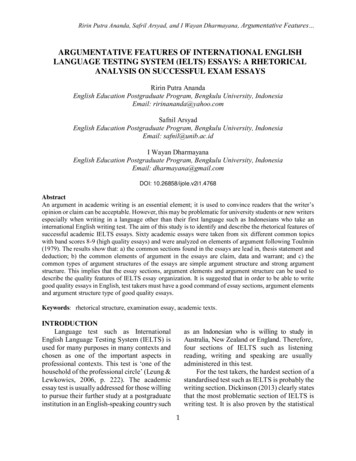
Transcription
Ririn Putra Ananda, Safril Arsyad, and I Wayan Dharmayana, Argumentative Features ARGUMENTATIVE FEATURES OF INTERNATIONAL ENGLISHLANGUAGE TESTING SYSTEM (IELTS) ESSAYS: A RHETORICALANALYSIS ON SUCCESSFUL EXAM ESSAYSRirin Putra AnandaEnglish Education Postgraduate Program, Bengkulu University, IndonesiaEmail: ririnananda@yahoo.comSafnil ArsyadEnglish Education Postgraduate Program, Bengkulu University, IndonesiaEmail: safnil@unib.ac.idI Wayan DharmayanaEnglish Education Postgraduate Program, Bengkulu University, IndonesiaEmail: dharmayana@gmail.comDOI: 10.26858/ijole.v2i1.4768AbstractAn argument in academic writing is an essential element; it is used to convince readers that the writer’sopinion or claim can be acceptable. However, this may be problematic for university students or new writersespecially when writing in a language other than their first language such as Indonesians who take aninternational English writing test. The aim of this study is to identify and describe the rhetorical features ofsuccessful academic IELTS essays. Sixty academic essays were taken from six different common topicswith band scores 8-9 (high quality essays) and were analyzed on elements of argument following Toulmin(1979). The results show that: a) the common sections found in the essays are lead in, thesis statement anddeduction; b) the common elements of argument in the essays are claim, data and warrant; and c) thecommon types of argument structures of the essays are simple argument structure and strong argumentstructure. This implies that the essay sections, argument elements and argument structure can be used todescribe the quality features of IELTS essay organization. It is suggested that in order to be able to writegood quality essays in English, test takers must have a good command of essay sections, argument elementsand argument structure type of good quality essays.Keywords: rhetorical structure, examination essay, academic texts.INTRODUCTIONLanguage test such as InternationalEnglish Language Testing System (IELTS) isused for many purposes in many contexts andchosen as one of the important aspects inprofessional contexts. This test is ‘one of thehousehold of the professional circle’ (Leung &Lewkowics, 2006, p. 222). The academicessay test is usually addressed for those willingto pursue their further study at a postgraduateinstitution in an English-speaking country suchas an Indonesian who is willing to study inAustralia, New Zealand or England. Therefore,four sections of IELTS such as listeningreading, writing and speaking are usuallyadministered in this test.For the test takers, the hardest section of astandardised test such as IELTS is probably thewriting section. Dickinson (2013) clearly statesthat the most problematic section of IELTS iswriting test. It is also proven by the statistical1
International Journal of Language Education, Vol. 2 No. 1, 2018 pp. 1-13data of mean band score for Academic IELTS;this writing section often gained the lowestmean band score of 5.5 in 2015–2017(IELTSWORLDWIDE, 2017). In the last threeyears, many test takers failed in IELTS writingessay test than in other sections of the test suchas speaking, reading, listening, vocabulary orgrammar test. This is probably becausepresenting a reasoned argument in writing asthe realisation of the analytical and criticalstyle of thinking is hard for the universitystudents (Ballard and Clanchy, 1984; Keraf,1992). It will be even more difficult for thosewho do not use English as their first language(Hatch, 1992; Purves, 1988).Writing an argumentative essay is animportant skill for university studentsespecially when they want to pursue theirfurther study in an English speaking countrysuch as Australia, England or the USA.University students may have studiedrhetorical features of their first language thatare reinforced by their education experience(Arsyad, 1999) but it will be a problematicchallenge for them when they write in English;their language may tend to look foreign.Because of this reason, they will experience anineffective communication in conveying theirmessage in their English essay. Whereas,writing IELTS essays require test takers tohave a good capability in writing to show theirhigher thinking process. Therefore, thestudents have to prepare themselves beforetaking the examination by studying therhetorical features of successful essays firstbecause different languages may have differentrhetorical features of academic essays (Hinds,1983 and Arsyad, 1999).An essay must have some importantsections and argument elements in order to besuccessful. Toulmin (1979) suggests that, anessay should consist of at least three mainsections and a thesis statement may consist ofup to six elements as presented below.Figure 1: Argument Model of anAcademic Essay (Toulmin, 1979)As seen in Figure 1, according to Toulminone of the three main sections of an essay musthave a thesis statement with a claim and mustbe supported by up to six elements such as data,warrant, backing etc. The five elements of anargument are aimed at justifying the claim putforward by the writer so that the claim is strongand therefore acceptable.Argumentative essays can be consideredas one of the most difficult types of writing towrite (Crasnich & Lumbelli, 2005; Gárate &Melero, 2005). The main problem in writingargumentative essays such as assigned inIELTS is the difficulty in organizing theargument to be as efficient argument becauseIELTS has its own limited numbers of wordsin essay to response the question (IELTS,2017). Starkey (2004) explains that animportant role of writer in writing a good essayis organizing the ideas into a logical and easyto follow format. Starkey adds that theorganization of an essay will guide andorganize the writing processes for the benefitof readers. If the test takers have a clearstructure in their mind, then it will be easier forthem to organize the content of the essay andwill represent the knowledge of the topic in thebest possible light to the reader.There have been a large number ofstudies on the writing section of languagetesting such as IELTS. These studies haveconcentrated mainly on comparing IELTSessay writing and university essay writing ingeneral (Moore and Morton, 2005). The resultsof this study revealed that IELTS essays have2
Ririn Putra Ananda, Safril Arsyad, and I Wayan Dharmayana, Argumentative Features some similarities with the main genre of theessay in University although there are someimportant differences. In her study, Dickinson(2013), applied genre-based methodtosupport students in writing IELTS essays asthey are frequently found in this test. Theresults showed that the most problematicsection in IELTS is writing section by thestudent. This method is offered not only toassist and prepare learners to find out theirmost immediate needs in achieving satisfactoryscores in such tests, but also to allowthem attain various goals in the future.More recently, Suryaningsih (2014)conducted a study on the students’ perceptionon IELTS and TOEFL writing tests. Theresults of this study showed that the test takersremarks IELTS and TOEFL tests diversely onthree important perspectives: on the tests, inthe tests and effects of the tests. Similarly,Ebrahimi (2014) conducted a status theme inthe IELTS Task 2 essays. This study foundthat the nature of genre of essay writingdirectly imposed the selection of the theme.The after effects of these investigations couldbe used as a part of the IELTS planning andcomposing classes to help the authors,particularly EFL beginner researchers toaccomplish palatable scores in composingpapers for IELTS test.Studies on writing essays have foundstudents’ problems in writing argumentativeessays such as those assigned in standardizedtests but none of them focused on the factorsthat can help test takers convince readers byusing arguments in order to make sense forreaders and how to build and develop theknowledge through successful writing.Argument in essay is very important to be usedto strengthen reasons and persuade the readersby the language. Rusfandi (2015) explains thatfactors that might contribute to thepersuasiveness of a given argument andstudent writers’ knowledge-building throughwriting are important to study. In addition,evolving and evaluating arguments must bestudied by the writer to embody, to initiate, orto simulate different kinds of ration (Wu & Allison, 2003). This isthe rationale for this study; that is to answer thefollowing questions:1. What are the main sections found insuccessful academic International EnglishLanguage Testing System (IELTS) essays?2. What are the elements of argument found insuccessful academic International EnglishLanguage Testing System (IELTS) essay?and3. What are the different types of argumentstructures (if any) found in successfulacademic International English LanguageTesting System (IELTS) essay?To answer the above questions, arhetorical analysis was conducted onsuccessful IELTS essays taken from IELTSmaterial 2017 with six different commontopics such as opinion, positive or negative,discussion, cause and solution, advantages anddisadvantages and two type questions.METHODSAn IELTS writing test consists of twotasks: task 1 and task 2. In task 1, examineesare requested to write a short description ofinformation presented in the form of a table,diagram while In task 2, examinees are askedto write an argumentative essay in response toa question or proposition. Tests designersdemonstrates that test takers in their responsesto the requirement of task 2 should providegeneral factual information, outline and/orpresent solution, justify an opinion, andevaluate ideas and evidence’ (UCLES, 2002).The upcoming study only focused on Task 2essay because it often poses heavier challengef o r IELTS’ test takers (Duigu, 2008).Another reason is the academic IELTS essaycould be the main influence on students’developing understandings of what academic3
International Journal of Language Education, Vol. 2 No. 1, 2018 pp. 1-13writing basically infold (Ebrahimi, 2014). Inaddition, Crowhurst (1991) says poorperformance in argumentative writing is oftenposed by even native English speakers1. The Corpus of the studyThese essays in the corpus of thisstudy came from the publicly available IELTSmaterial 2017 sample essay answers with bandscore 8-9.Table 1. The Distribution of Successful Essays of Academic IELTS in the Corpus of the study(IELTS Materials, 2017)No1OpinionOPIELTS MaterialsNumber ofEssay102Positive or NegativePNIELTS Materials10345DiscussionCause and SolutionAdvantages andDisadvantagesTwo Type QuestionsDSCSADIELTS MaterialsIELTS MaterialsIELTS Materials101010TQIELTS Materials10606TotalTypes of QuestionCodePublisherEssays of six different topics were analyzed inthis research; these are opinion, positive ornegative, discussion, cause and solution,advantages and disadvantages, and two typesquestions. The data were selected based onthree criterion such as genre, English ForAcademic Purpose (EAP), and text type(Ebrahimi, 2014). In addition, Ebrahimi(2014) suggests that essay writing (task 2essays of IELTS in this study) is qualified as agenre. According to Ebrahimi, it was alsoselected as the EAP essay writing andappropriate text type for this research as itcontains characteristic of rhetorical features.analysed by using text analysis technique usinga simple sentence as the smallest unit analysis.Then, the sections of the essay and theelements of the argument in the essays wereidentified by the help of key words, discoursemarkers and inference. The rhetorical featuresoccurring in the essays were calculated andcompared with those found in the literaturereview. In addition, an inter-rater wasemployed to analyze and ensure the reliabilityof the rhetorical analysis on twelve essays(20% of the total sample in the corpus of thestudy); the results show a high inter-raterreliability rates (88,9%). Both raters had towork out the coding disagreement if it occurredtill the satisfactory level was gained. Then, thetwo researchers analyzed the rhetoricalfeatures in other Academic IELTS essay inorder to gain a full agreement result.2. Data AnalysisThe argument model used in this researchwas adapted from Toulmin (1979) consistingof lead in (LI), thesis statement (TS), claim (C),data (D), warrant (W), backing (B), qualifier(Q), Rebuttal (R) and deduction (DD). Sixdifferent common topics with band score 8-9were analysed to represent the peculiarrhetorical features in successful AcademicIELTS essay. To find out the answers ofresearch questions in this study, the data wereRESULTS1. The Main Sections found in AcademicIELTS EssayThe first analysis was on the main sectionsfound of the essays and the results are aspresented in table 2 below.4
Ririn Putra Ananda, Safril Arsyad, and I Wayan Dharmayana, Argumentative Features Table 2. The Common Sections in the Successful IELTS Exam EssayNoSection of EssayEssay TopicsOPPNDSCS#10#10#10#101.2.3.Lead inThesis 10101010101010Total%606060100100100As indicated in table 3, lead in, thesis statementand deduction are categorized as the obligatorysections in academic IELTS essay because thedegree of the occurrence consistency isperfectly high. All of them appear in all or 100%in successful academic IELTS essay. Here arethe examples of those three sections such aslead in, thesis statement and deduction. Itindicates that those elements are obligatorysections which means that these sections arecompulsory used in writing task 2 AcademicIELTS essay as the main sections. Here are theexamples of those three sections.essay, this is where the thesis statement comesto its own. As shown on the table that thissection is also the main section in the essaywith the percentage 100 %. Below is anexample.Example 1As can be seen from example above, the thesisstatement is shown by the presence of onesentence statement ‘I would argue that it isbetter for children to be looked after by theirgrandparents’. This statement originally comesfrom the authors’ opinion that focuses ontelling the readers about the essay point. Inother words, thesis statement is as the mainidea that controls the argument of the essayitself.The presented argument has beenannounced to convince the readers that theauthor’s opinion can be acceptable. Therefore,at the end of the essay, the author must stateand affirm the implication of what has beenpresented to support the author’s position. Thisis where the deduction comes into its own. Asshown on the table 2, the percentage ofdeduction is also perfectly high (100 %).Below is an example of deduction.Example 2Currently, many parents tend to be busyworking, and they need to rely on someone elseto take care of their offspring. While somepeople think childcare organizations can offerthe best care, I would argue that it is better forchildren to be looked after by theirgrandparents. (About IELTS, 2017)Education for offenders during imprisonment asa method to reduce the rate of crime has evolvedas a major topic of concern in today’s society.While I agree that such a solution is effective toreduce crime, I am convinced that it is far frombeing the best method and there are many betterways of reducing crime. (About IELTS, 2017)As can be seen from the example above, leadin is shown by the presence of the sentenceabout the fact of education for offenders in thebeginning of the paragraph related to theresponse of the authors to the topic given. Inthis example, lead in is indicated as the openingsentence to arouse the readers interest,introduce the subject and establish the focusand direction for the essay. In this part, theauthors have to look for the idea related to thetopic and avoid copying the essay topic or theywill not get the point at all. After stating thelead in to get the readers interest about thetopic, the author must present the goal of the5
International Journal of Language Education, Vol. 2 No. 1, 2018 pp. 1-13Example 3to reach the implication of the presentedarguments in order to make one last effort toensure the reader, to suggest largerimplications about the evidence that has beenpresented, and absolutely to provide asatisfying sense of closure.As shown in the example above, the deductionis shown by the sentence “an increase in theworld’s demand for natural resources is posinga number of threats to society. “However, thiscan be handled by adopting above mentionedsuggestions”. This statement shows that thereis a process of arguments explained by theauthor to ensure the reader arranged regularly2. The Elements of Argument used inAcademic IELTS EssaySix elements of argument as suggested byToulmin (1979) were found in the data of thisstudy. Table 3 below shows the result of dataanalysis.In conclusion, an increase in the world’sdemand for natural resources is posing anumber of threats to society. However, this canbe handled by adopting above mentionedsuggestions. (About IELTS, 2017)Table 3. Elements of Argument in the IELTS Successful Exam EssaysElements ofEssay 0101091010Table 3 demonstrates that the highestpercentage of argument elements found in thecorpus of this study is claim and data with 60or 100% appearance which indicates that thedegree of consistency of the occurrence ofthese elements are perfectly high. It alsoindicates that those are as obligatory elements.As indicated from the table 3, lead in, thesisstatement and deduction are indicated as theobligatory sections in academic IELTS essaybecause the degree of the occurrenceconsistency is perfectly high. All of themappear 100% in successful academic IELTSessay. Here are the examples of those threesections such as lead in, thesis statement anddeduction. Below is an 0010073358,323,3Example 4On the one hand, it is significant that schoolchildren should learn about their localhistory. Firstly, knowing about the past oftheir region or country will foster a sense ofbelonging and pride in each child. Forexample, by studying how’ earliergenerations fought and made sacrifices forthe freedom of the country, Vietnameseyoungsters will appreciate more the value ofthe way of life and liberty that they enjoytoday (About IELTS, 2017)As shown in the example above, thepresence of claim is indicated by the word‘should learn about their local history’ in thesentence’; this claim is categorized as claim ofpolicy which show that a certain conditionmust exist. In addition, the exampledemonstrates that the ‘claim’ must be6
Ririn Putra Ananda, Safril Arsyad, and I Wayan Dharmayana, Argumentative Features debatable so that the authors can be easier toargue for. In addition, this exampledemonstrates that academic IELTS essay claimor body part is used to present essays’ goals,direction and scope, and is supported byevidence, examples, argumentation, expertopinion, statistics, and telling details. Itindicates that the claim must be debatable. Itmust be argumentative. When the authorsmake a claim, the authors are arguing for acertain interpretation or understanding of thetopic.A good claim is specific, it makes afocused argument. However, the claim will benothing without the presence of “data” assupporting sentence to make the claim morelogical and persuasive. As shown on table 3,the percentage of data is 100%. It indicates thatthis element is an obligatory element. Here isthe example of data in one of the essays.considering the fundamental reasons neededto support the claim.It turns out, this case implies thatInformation utilized as a part of the AcademicIELTS essay is typically strong andpersuasive argument. Although in fact, itcould affect the readers in different way.Therefore, this is where the warrant comesinto its own. As shown on table 3, thepercentage of warrant is 73 %. It is indicatedas conventional element. The example ofwarrant can be seen below.Example 6On the other hand, I believe this developmenthas far more drawbacks. The first one is thattravelling to remote natural areas can be riskyif the travellers are not sufficiently prepared.For instance, the temperature at the South Poleis usually very low, which adversely affectspeople’s health. Travelling to forests can alsobe dangerous as people have to face the risk ofbeing attacked by animals. Also, since visitingisolated places often requires a large amount ofinvestment in researching and ensuring thesafety of travellers, the costs of travelling tendto be high. (W)Therefore, it seems like onlyscientists and rich people can afford thisactivity, so this development is likely to benefitonly a small group of individuals. (AboutIELTS, 2017)Example 5On the one hand, it is significant that schoolchildren should learn about their local history.(D) Firstly, knowing about the past of theirregion or country will foster a sense ofbelonging and pride in each child. For example,by studying how’ earlier generations fought andmade sacrifices for the freedom of the country,Vietnamese youngsters will appreciate more thevalue of the way of life and liberty that theyenjoy today. Secondly, young children alsolearn about the origins and core values of theirmotherland through history lessons (AboutIELTS, 2017)As shown on the example, the warrant isshown by the presence of the word “It seemslike only scientist and rich people”. This wordindicates that there is a logical relationship orimplication between the claim and the data.This example clearly demonstrates that theuse of warrant is to make a relation orimplication between the claim and datastronger. However if claim and data are clearenough and do not make an ambiguity inreaders’ mind, then the use of warrant couldbe ignored.From the examples of data above, itdemonstrates that data is shown by thepresence of telling details and examples afterstating the claim at first in order to supportand strengthen the claim itself. In addition, theexample demonstrates that the data takesimportant role because claim cannot standalone without the data. The data is a part of7
International Journal of Language Education, Vol. 2 No. 1, 2018 pp. 1-13In particular situation, warrant is neededto be examined whether the statement orassumption in this element is relevant orrational with the claim and data or not.Therefore, the use of another element such asbacking is needed. As shown on table 3,backing was found in academic IELTS essaywith percentage 35 % indicated as the optionalelement. Below is the example of backing.respect the law, and traffic accidents can belimited. Another solution is to encourage peopleto use public transport rather than privatevehicles. This can be done by reducing the priceand increasing the frequency of buses and tubesto make it more convenient for users. (AboutIELTS, 2017)This example demonstrates that therebuttal is shown by the presence of the word“however”, it becomes the characteristic of therebuttal because the authors use this word todefend their argument and clearly state thattheir own argument/position is the best one andcan be more accepted by the readers. Thisexample is kind of rebuttal which is written inthe form of complete sub-section of argument;this can be, because rebuttal is actuallyargument in itself, so it may include others subsections together such as claim, data, warrantand etc.In argument, the authors must bring thestrong data related to the topic given, howeversometimes there is one condition that the datacannot be applied universally. Therefore, this iswhere the qualifiers come into its own. Asshown on the table 3, qualifier was found inacademic IELTS essay with the percentage 8,3% indicated as optional element. Here is theexample of qualifier.Ex]ample 7Yet the world is a very different place from howit looked in 1945, which has led some people toquestion the need for a powerful organisationlike the UN. (B) In particular, there are someproponents of free trade who argue thatcompetition and not cooperation betweennations is the fastest way to pursue economicdevelopment. (About IELTS, 2017)From the example above, the backing is shownby the presence of the sentence “someproponents of free trade who argue that ”therole of this sentence is to justify assumptionsstated in the warrant proven by giving anevidence such as information from theparticular people whose credibility could beaccepted by the readers to strengthen theassumption stated in the warrant.On the other hand, in one situation thepresented argument must be challenged byexplaining and supporting the claim withdifferent point of view. This is where anotheroptional element called as rebuttal comes intoits own. As shown on table 3, rebuttal was foundin academic IELTS essay with the percentage23.3 % indicated as optional element. Below isan example of rebuttal.Example 9When there is no limit to the indulgence parentsshow toward their kids, these children willbecome needy and dependent, and therefore areunable to live on their own. In some cultures likeVietnam, parents pick up their kids at schooleven during high school, buy their clothes andcook at home. Children do not have to doanything, which is mainly why many of themcannot stay away from their parents and liveindependently even when they are in their 20s.(About IELTS, 2017)Example 8However, I would argue that there are muchbetter methods of ensuring road safety. The firstone is to have stricter punishments for drivingoffenders. For example, people who breaktraffic rules should be required to pay huge finesor be banned permanently from commuting onthe street. This makes commuters more likely toAs indicated from example above, the lastsub-section is qualifier which shown by thepresence of words such as ‘some’ 'most','usually', 'always' or 'sometimes' combined8
Ririn Putra Ananda, Safril Arsyad, and I Wayan Dharmayana, Argumentative Features with the sentence to hence range from strongclaim. This sub-section is used to indicate thestrength of the leap from the data to thewarrant and may limit how universally theclaim applies.from a clear and unambiguous languagestructure. Below is an example.Example 10Claim : On the other hand, I consider thateducation has a complementary role toplay.Data : Firstly, in schools, students should studysome aspects of the law which affecttheir lives. Having some knowledge ofthe law, students are better prepared toavoid situations which may involve themin crime or becoming a victim. Forexample, youngsters must study theimportant laws about driving and roadsafety. Secondly, in prisons themselves,educational programmes must aim toprovide prisoners with skills andqualifications to find work when theyare released. (About IELTS, 2017)3. The Different Types of ArgumentStructuresThe six elements of argument examinedin this research can be classified into twodifferent types of argument structure: simpleargument structure and strong argumentstructure. This structure below is used toconduct the main body part of the essay. Toprove whether the thesis statement of theessay is true or not, the test takers need to givesupporting sentences/paragraph to convincethe examinees that the authors’ side is correctone. Therefore, these elements below are theimportant ones in conducting a goodargument. In the other words without theposition of the claim will be stronger if the testtakers use these elements.ClaimFrom the example above, claim and data areused as the element of the argument. Claim isshown from the presence of the sentence“education has a complementary role toplay” the author attempt to convey the claimof fact proven by the following data after theclaim. It consists of telling details shown bythe words “firstly, secondly” and exampleshown by the words “for instance”. Thisstructure is indicated as the simplest structurewhere the author only put a claim and relevantjustification regarding to the topic given. ObligatoryData ObligatoryFigure 3: The Structure of Simple ArgumentStructureAs shown on figure 3, the simple argumentstructure consisting of claim and data found inAcademic IELTS essay. In this pattern, theconclusion is made after the reasons thatsupport a claim. Although these two elementsexist, it does not mean that the argument isacceptable or appropriate. Claims orappropriate conclusions should indicate therelevant relationship between ground andclaim. Therefore, it needs to be reviewedcarefully, whether the claim has beenformulated clearly. Claim is clearly visibleFigure 4: The Structure of Strong ArgumentStructureAs shown in figure 4, there are threecompulsory elements to elaborate theargument in writing essays academic IELTS9
International Journal of Language Education, Vol. 2 No. 1, 2018 pp. 1-13task 2. They are claim and data, then therelationship between claim and data affirmedby warrant as the conventional element whichmeans that this element also used as theprimary elements in writing essay. On theother hand, there are others elements used asoptional elements that can strengthen thearguments such as backing, modal qualifierand rebuttal which is indicated ascomplementary elements. It indicates thatthose elements are not always used inelaborating the essay but these elements areavailable to be chosen in supporting andstrengthening the claim. Therefore, theexample below present the different type ofstructure found in academic IELTS essaycategorized as strong argument structure.Below is an example.many people in the public who have theintention to carry out a crime. There arealso other educational methods that mayhave a stronger and more long-lastingimpact on the reduction of crime. Anexcellent example of this is crime educationat school, which helps equip students withthe necessary knowledge about crime andcrime prevention. This measure isundeniably a more sustainable crimefighting solution than education forcriminals. (Abo
An argument in academic writing is an essential element; it is used to convince readers that the writer’s opinion or claim can be acceptable. However, this may be problematic for university students or new writers especially when writing in a language other than their first
